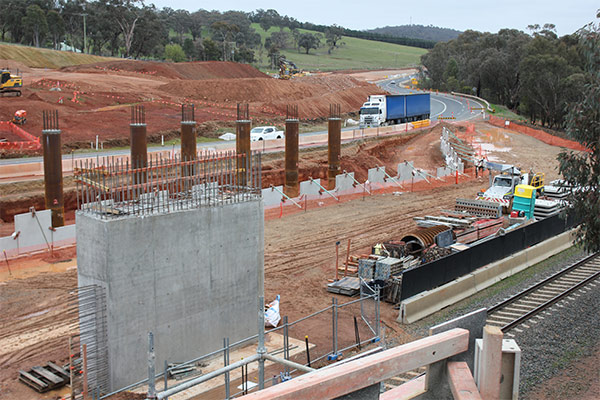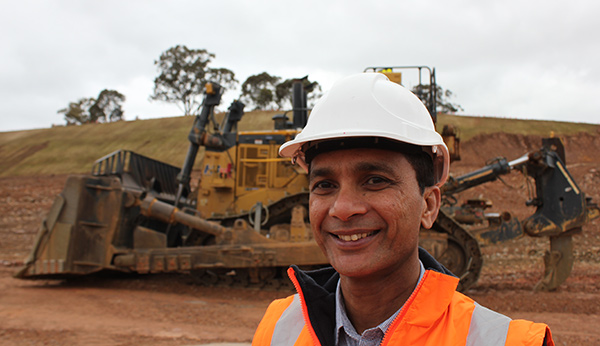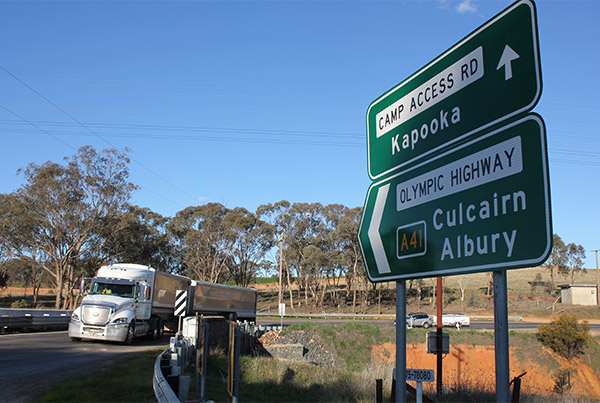One of the biggest bridge projects in regional Australia will allow bigger trucks to use bigger stretches of road in the east
Kapooka is one of Australia’s most strategic locations in more ways than one.
The Kapooka military base, near Wagga Wagga in southern New South Wales, is where new recruits to the Australian Army do their basic training before being sent all over the country.
Describing its training as ‘world-class’, Kapooka’s equipment and infrastructure is no doubt right up to date with modern warfare.
In contrast, the Olympic Highway bridge leading to the base from the south is a relic from the days of the Boer War, horses and carts and steam trains.
Built over the main Sydney to Melbourne rail line in 1880, Kapooka Bridge is one of the chokepoints for heavier trucks wanting to travel to or from various locations in Victoria and NSW.
It’s also on a popular truck route between Melbourne and Brisbane, connecting with the Newell Highway at West Wyalong in NSW.
At present, only 23m B-doubles grossing the standard 62.5 tonnes are allowed across the brick arch bridge, and only one B-double at a time is able to negotiate the right-angle approaches from either side.
Broken brickwork is testament to the fact that not all of them have successfully managed the tight manoeuvre.
But by about September next year this will all change when the $55 million Kapooka Bridge project is completed.
Most trucks won’t even have to change gears as they cruise the new flyover that is fast taking shape.
They will be able to pull HML (Higher Mass Limits) loads of 68 tonnes.
 |
|
Looking from the top of the first pier structure north to one of the columns for the second pier structure, with the piles for the northern abutment in the background near the current road. There is enough room for the railway line in the bottom right corner to be duplicated and for trains to carry double stacked containers.
|
On same track
There are more than 150,000 truck movements a year across Kapooka Bridge.
A lot of those are B-doubles belonging to Ron Finemore Transport, a substantial eastern Australian operator carting a lot of groceries, temperature-controlled food, fuel and bulk rural commodities among other freight.
Ron Finemore started in trucking at Wagga Wagga many years ago, but now his operation is headquartered at Wodonga on the NSW-Victorian border.
He is chair of the NSW Freight Advisory Council, and was at the Kapooka project in May for an inspection with NSW roads minister Duncan Gay and local state MP Daryl Maguire.
“B-doubles, for example carrying general freight or livestock from southern NSW to Victoria, will now experience a safer journey and greater productivity along this vital transport route,” Finemore said at the time.
“The last time I stood next to the old bridge with the Minister and local member, longer trucks had to cross over to the wrong side of the highway to negotiate the tight dog-leg bends, which was extremely dangerous.
“As a veteran of the road transport sector, I’m delighted the NSW and Australian governments are listening to the transport and freight needs of regional communities.”
The federal and NSW governments have gone 50-50 in the project, which is a flagship for the Bridges for the Bush program in NSW.
Minister Gay said: “Replacing the old crumbling Kapooka road over rail bridge and straightening its dog-legged approaches is yet another example of how the NSW and Australian governments are working together to remove notorious transport and freight pinch points in regional NSW.”
The NSW Government says the new structure will remove the only remaining weight-constrained bridge on the Olympic Highway, opening up an extra 315km for more productive trucks.
The Olympic Highway runs between Cowra in central western NSW and the Hume Highway just north of Albury on the Victorian border.
Its big new bridge will leave enough room for the main southern rail line running underneath to be duplicated, and for trains to carry double-stacked rail containers.
 |
|
Stars of the show: supervising RMS engineer Anthony Perera with the project’s D11 dozer in the deepest cutting.
|
Big responsibility
The Kapooka job is being carried out by BMD Constructions with several subcontractors, and is being supervised by NSW Roads and Maritime Services (RMS).
The RMS engineer in charge is Anthony Perera, a veteran of road and bridge building in Australia since migrating from Sri Lanka as a young civil engineer in the mid-1990s.
He has to make sure the road approaches will last at least 50 years, and the bridge 100 years.
“It’s a huge responsibility and we have a very experienced team helping make my life so much easier,” Perera says.
Perera worked with construction companies John Holland and Nace on some big projects including the Taree bypass on the Pacific Highway in NSW, before joining the RMS in Wagga Wagga a dozen years ago.
“Beautiful, fantastic. I love it,” is how he describes life in the city on the junction of the Sturt and Olympic Highways, not far off the Hume.
Perera has seen road and bridge building become more environmentally friendly over the years.
Trees have had to be cut down for this project, so lots of birds’ nesting boxes have been put on nearby trees that remain.
Rather than just letting silt from exposed dirt and rock run into the local creek, there are several sediment ponds to catch the ‘dirty’ water. Lime and gypsum are added to make the sediment drop, and the remaining ‘clean’ water is tested and pumped out.
There was a lot of brown water in the sediment ponds when TradeTrucks visited, thanks to a fair bit of recent rain that had slowed down the job, but was badly needed by local farmers.
 |
|
Common sight on the old bridge: a Ron Finemore B-double.
|
Strong supports
It’s pretty amazing to see how BMD is going about building a bridge along with the new road approaches to it.
The Kapooka project is nearly 3km long, and involves three cuttings into hillsides, one of them nearly 20m deep. At one point there will be an overtaking lane.
The massive amount of soil and rock dug out is more than enough to raise the other stretches of new road emerging from the farmland.
The highest build-up using cutting fill is 10m.
Meanwhile the southern bridge abutment is 15m high to the surface level.
Each of the two abutments is supported by seven massive piles each.
These are circular steel and concrete columns 90cm in diameter that go down about 20m under the ground.
There are another 24 of these piles supporting the pier columns on the bridge structure itself.
The bridge will be 99m long, made up of three 33m spans.
Each span will comprise 11 steel-reinforced concrete girders to be trucked in from Melbourne, needless to say as oversized loads.
Keep an eye out on the Hume between Melbourne and Albury in November, when 33 jinkers will be on the move with the girders.
From the south, the girders for the first span will rest on top of the southern abutment and pier 1; the second span will be held up by piers 2 and 3; and the third span will sit on top of pier 3 and the northern abutment.
Then a steel-reinforced concrete deck will be built on top.
 |
|
A Cat crossing the old Kapooka bridge from the south.
|
Knowing the road
A road is a more complex thing than you might imagine. It’s made up of many compacted layers.
The road sections vary in the types and depth of the various layers and top surfaces.
On top of the fill is what’s called ‘selected material’ crushed on-site; then various strata of ‘sub-base’ and ‘base’ layers of crushed rock trucked in from quarries. These three types of road foundation might be 70cm thick.
On top of them will be a pavement layer of hot bitumen seal with gravel spread on top and then rolled into it.
There will also be one short section of longer-lasting asphalt, at an intersection where trucks will be turning and therefore causing more stress on the road.
The asphalt will be 25cm thick, in three layers. It’s pre-mixed from bitumen, sand and gravel in a batching plant, and is poured on hot. It looks uniformly black with no gravel sticking out of it.
Asphalt road is smoother and quieter than a bitumen/gravel, but despite appearances, it’s no more slippery when wet.
You often see stretches of asphalt on top of concrete freeways near residential areas, to keep the tyre noise down a bit.
There won’t be enough truck traffic to warrant concrete road pavement on the approaches to the new Kapooka Bridge. Concrete needs less maintenance but is much more expensive.






